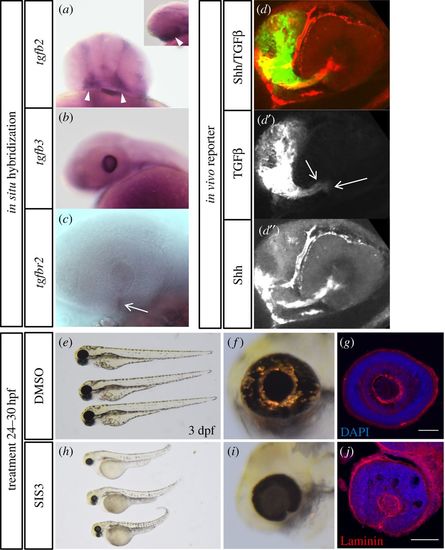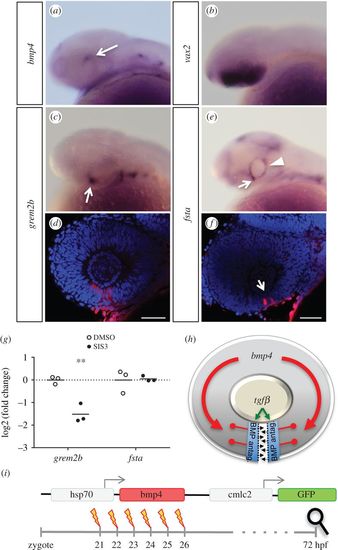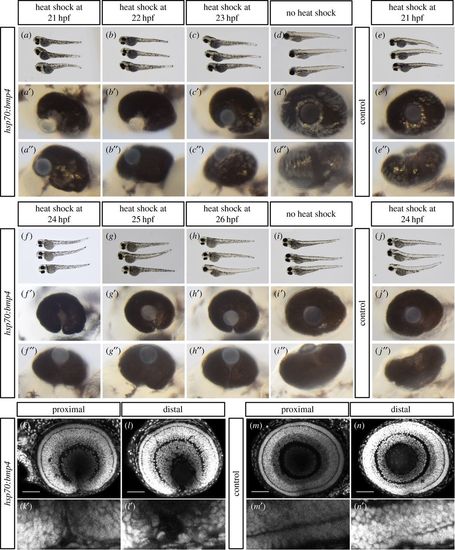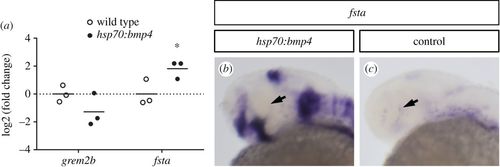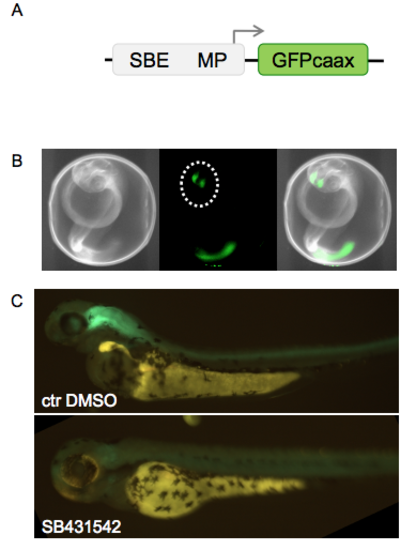- Title
-
TGFβ-facilitated optic fissure fusion and the role of bone morphogenetic protein antagonism
- Authors
- Knickmeyer, M.D., Mateo, J.L., Eckert, P., Roussa, E., Rahhal, B., Zuniga, A., Krieglstein, K., Wittbrodt, J., Heermann, S.
- Source
- Full text @ Open Biol.
|
TGFβ in the zebrafish eye. (a) Whole-mount in situ hybridization (WMISH) of tgfb2 (30 hpf), frontal view. Small image shows a lateral view. Note expression in periocular tissue (arrowheads). (b) WMISH of tgfb3 (30 hpf), lateral view. Note expression in the developing lens. (c) WMISH of tgfbr2 (30 hpf), lateral view. Note expression in the optic fissure (arrow). (d) In vivo signalling for TGFβ (green) and Shh (red) for orientation, split into TGFβ (d′) and Shh (d″), at 24 hpf. Active TGFβ signalling in the optic fissure margins (d′, arrows). (e–j) Embryos (3 dpf) treated with DMSO (e–g) or specific inhibitor of Smad3 (SIS3, h–j) from 24 to 30 hpf. Sagittal sections through eyes of (g) DMSO and (j) SIS3-treated embryos at 3 dpf, stained with DAPI and anti-Laminin. SIS3-treated embryos show a persisting optic fissure with persisting basal lamina and absence of retinal layering. EXPRESSION / LABELING:
PHENOTYPE:
|
|
BMP antagonists grem2b and fsta are expressed in the optic fissure. WMISHs were performed at 30 hpf and are shown in lateral view. (a) bmp4 is expressed in the dorsal optic cup (arrow). (b) Expression of vax2 in the ventral retina. (c,d) Expression of grem2b in the optic cup is restricted to the optic fissure (arrow). (d) Confocal view of grem2b expression (red) with DAPI counterstaining (blue). (e,f) fsta is expressed in the optic fissure (arrows), as well as the ciliary marginal zone (CMZ, arrowhead). (f) Confocal view of fsta expression (red) with DAPI counterstaining (blue). (g) Expression analysis of gremlin and follistatin by quantitative PCR, differential expression in heads of SIS3-treated embryos (30 hpf) as represented by the log2(fold change) of individual samples. Embryos were treated from 24 hpf onward, controls were treated with DMSO. Material from three individuals was pooled for one sample; n = 3, horizontal bars represent the arithmetic mean. p-Values for grem2b and fsta, 4.3 × 10−3 and 0.877, respectively. (h) Model of the proposed role of TGFβ and BMP antagonism during optic fissure fusion. TGFβ signalling domains in the optic fissure margins are shielded from BMP by induced BMP antagonists. (i) Scheme of a heat shock inducible BMP construct used to create the transgenic line tg(hsp70:bmp4, cmlc2:GFP). GFP expressed under the cardiac cmlc2 promoter serves as transgenesis marker. Experimental procedure using heat shocks at different time points between 21 and 26 hpf to induce bmp4 expression, aiming at disrupting optic fissure fusion. Analysis of phenotypes was scheduled for 3 dpf. |
|
Differentially timed induction of bmp4 causes different coloboma phenotypes. (a–e) Gross morphology of (a–d) tg(hsp70:bmp4, cmlc2:GFP) embryos after heat shock at 21, 22, 23 hpf, no heat shock, and (e) wild-type embryos heat shocked at 21 hpf. (a′–h′) Close up, lateral view, (a″–h″) close up, ventral views. Early bmp4 induction impairs optic cup morphogenesis, resulting in coloboma (a′–c″). (f–j) Gross morphology of (f–i) tg(hsp70:bmp4, cmlc2:GFP) embryos after heat shock at 24, 25, 26 hpf, no heat shock and (j) wild-type embryos heat shocked at 24 hpf. (f′–j′) Close up, lateral view, (f″–j″) close up, ventral views. Late bmp4 expression hampers optic fissure fusion, resulting in coloboma (f′–h″). All animals were visualized at 3 to 3.5 dpf. (k–n) Lateral confocal images of larval eyes (3 dpf) stained with DAPI. Individuals were heat shocked at 24 hpf. Tg(hsp70:bmp4, cmlc2:GFP) animals show a persisting optic fissure (k,l) while their wild-type siblings do not (m,n). (k′–n′) are magnifications of the optic fissure region. Notably, the fissure margins are touching in the proximal part of the eye (k′). PHENOTYPE:
|
|
Timed induction of bmp4 affects expression of BMP antagonists. (a) Expression analysis of gremlin and follistatin by quantitative PCR, differential expression in heads of tg(hsp70:bmp4, cmlc2:GFP) embryos at 30 hpf after heat shock at 24 hpf as represented by the log2(fold change) of individual samples. Material from three individuals was pooled for one sample; n = 3, horizontal bars represent the arithmetic mean. p-Values for grem2b and fsta, 0.170 and 0.049, respectively. (b,c) WMISH for fsta (30 hpf) in tg(hsp70:bmp4, cmlc2:GFP) after heat shock at 24 hpf (b) and control embryos (c). Strong upregulation after the heat shock is seen in the optic fissure and other expression domains, but not the ciliary marginal zone (arrow). WMISHs in (b) and (c) were stained in parallel for the same amount of time. |
|
Establishment of a TGF signalling reporter in zebrafish. (A) Construct for the TGFβ signalling reporter. Multimerised Smad Binding Elements (SBEs) in combination with a minimal promoter (MP) drive membrane localised GFP (GFPcaax). (B) Bright field, fluorescent and merged images of a zebrafish larva expressing the TGFβ signalling reporter construct (21.5 hpf). Note the expression domains in the forebrain (encircled) and the tail. (C) SB431542 reduces TGFβ reporter activity, DMSO treated fish as control. Treatment was administered from 24 hpf to 48 hpf. The inhibitor was renewed during the time of the treatment. |

